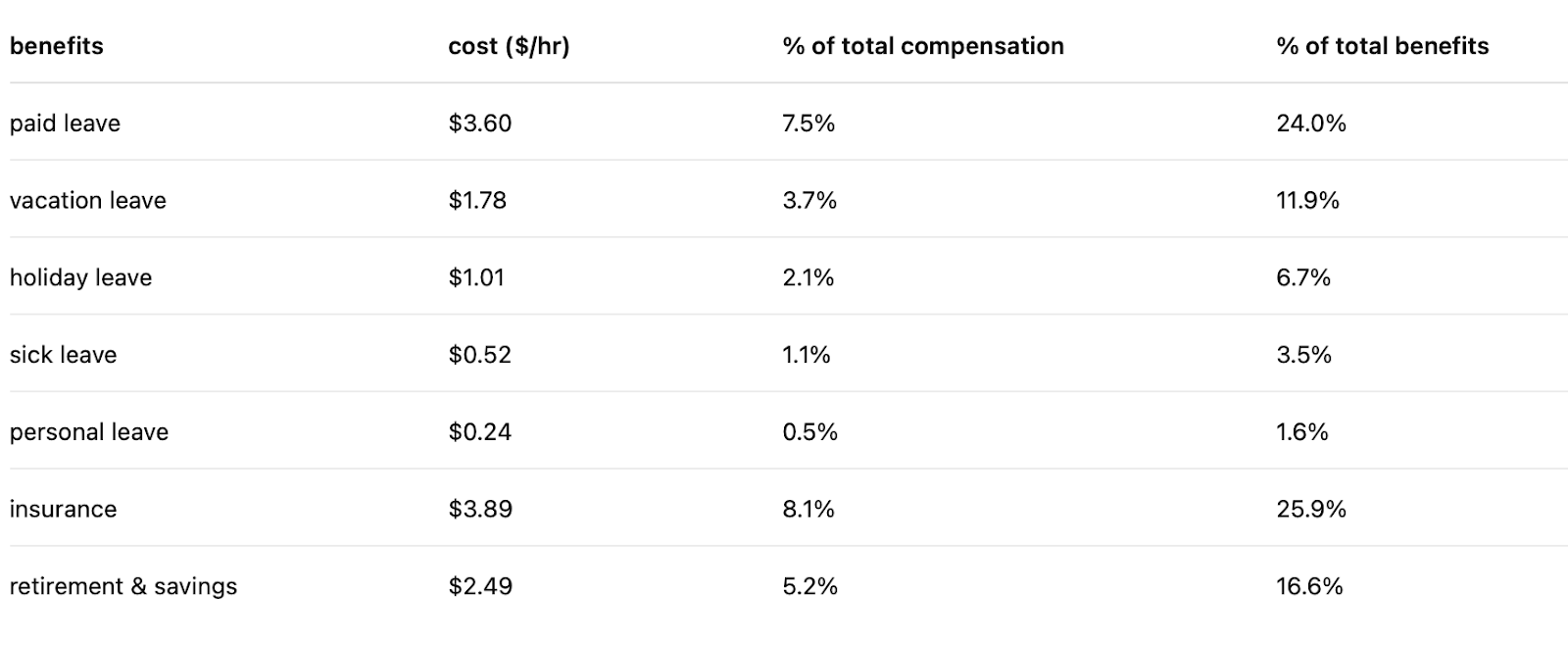
How much do benefits cost per employee: the complete guide
Learn about the various types of benefits, average expenses, and effective strategies to manage costs while ensuring employee satisfaction. Stay informed and make smart decisions for your team with our complete guide to the cost of employee benefits.
In this piece
As one of the key expenses for employers, benefits play a significant role in the overall cost of hiring and retaining employees.
Employers typically offer a variety of benefits to attract and retain top talent, including health insurance, retirement plans, paid time off, and other perks.
The cost of these benefits can vary depending on the type and level of coverage offered and the number of employees on the plan.
In this article, we will break down the average costs associated with various types of benefits to provide a comprehensive overview for employers and HR professionals.
More importantly, we'll also provide practical strategies to achieve an optimal return on your investment and manage costs effectively.
Key takeaways
- Benefits vary in cost, influenced by factors like company size, industry, and benefit types.
- Average benefits costs can be a significant part of total compensation, differing across private, public, and civil sectors.
- Types of benefits include health insurance, retirement plans, paid time off, and more, aiming to increase employee economic security and retention.
- The benefits and base salary ratio averages around 30% to 40%, but varies by sector and occupation.
- Factors affecting benefit costs include company goals, employee demographics, industry standards, and geographic location.
- Employers should budget for legally required benefits, retirement, PTO, work-life balance perks, professional development, childcare, health-related benefits, and more.
- Strategies for optimizing benefits include flexible providers, regular package reviews, focusing on ROI, understanding employee needs, effective communication, offering choice, utilizing technology, and training managers.
- ROI evaluation involves setting objectives, gathering data, analyzing costs, benchmarking, and continuous monitoring.
What are employee benefits?
Employee benefits, or perks or fringe benefits, are various types of non-wage compensation provided to employees in addition to their normal wages or salaries.
These benefits include health insurance, retirement plans, life insurance, disability insurance, paid time off, child care, tuition reimbursement, and other similar types of non-cash compensation.
The purpose of employee benefits is to increase the economic security of staff members and, in doing so, improve worker retention across the organization.
While some benefits are legally mandated in certain countries or states, employers voluntarily offer flexible benefit plans to attract and retain talent or provide a more comprehensive compensation package.
Total cost of employee benefits
Understanding the total cost of employee benefits is essential for any hr team planning their budget and compensation strategy. benefits aren’t just add-ons; they represent a significant portion of total labor costs and can impact hiring, retention, and compliance.
As of 2025, employers in the United States spend an average of $47.92 per hour worked per employee. Of that amount, about $15.00, or 31.3%, goes toward benefits, including health insurance, paid time off, retirement contributions, and legally required benefits like social security and medicare.
While the specific cost can vary by industry, job type, and company size, one thing is consistent: benefits make up a major share of overall compensation. and with rising expectations around flexible benefits, wellness, and remote work support, employers need clear, up-to-date data to make smart, sustainable decisions.
In the sections below, we break down how much employers are really spending on benefits, by sector, benefit type, and job category, so you can benchmark your strategy and plan with confidence.
What is the average cost of benefits per employee?
Here’s a current snapshot of the average employer costs in the U.S. as of March 2025, according to the Bureau of Labor Statistics:
General overview

Breakdown of benefits (Civilian workers $/hr)

Average cost of benefits by private sector occupation
- Management, professional and related: $22.08 (30.7% of compensation)
- Sales & office: $9.04 (28.3%)
- Service: $5.01 (22.7%)
- Natural resources, construction and maintenance: $14.58 (33.2%)
- Production, transportation and material moving: $11.20 (32.4%)
Average cost of benefits by state and local government sector occupation
- Management, professional and related: $26.94 (36.1%)
- Sales & office: $18.15 (42.2%)
- Service: $20.62 (42.9%)
Average cost of benefits by civil sector occupation
- Management, professional and related: $22.33 (31.9% of compensation)
- Sales & Office: $9.49 (28.8% of compensation)
- Service: $6.42 (26.8% of compensation)
- Natural resources, construction and maintenance: $14.58 (32.8% of compensation)
- Production, transportation and material moving: $10.99 (32.4% of compensation)
Cost of employee benefits by type
- Insurance: $3.04 (25.7% of total benefits)
- Legally Required Benefits: $3.02 (25.5%)
- Paid Leave: $2.99 (25.2%)
- Supplemental Pay: $1.42 (12%)
- Retirement and Savings: $1.37 (11.6%)
What is the ratio between benefits and base salary?
The average benefit-cost ratio in 2025 is around 31% for civilian workers, meaning employers spend about 31 cents in benefits for every dollar paid in wages. Ratios vary by sector:
However, this ratio can vary depending on the benefits offered and the industry.
Benefit-cost ratios by sector

What impacts the cost of your employee benefits package?
The cost of employee benefits can vary depending on a variety of factors, such as the size of the company, industry, location, and the types of benefits offered.
Here are some key factors that can influence the costs of employee benefits:
1. Company needs and goals
The first determinant of the cost of employee benefits is the specific needs and goals of the company. This is vital because the benefits package should align with the organization's objectives.
For a measurable return on your investment, it's best to set a budget bracket for employee benefits.
The ratios and guidelines mentioned above can serve as a good starting point.
2. Types of benefits offered
The more comprehensive the benefits package, the higher the costs.
For example, offering only health insurance will cost less than offering health insurance, retirement plans, and other perks like tuition reimbursement.
Employers need to carefully consider which benefits are necessary and desirable for their employees and budget accordingly.
We recommend an employee survey to help determine which benefits are valued most by the workforce.
3. Employee demographics
The age, gender, and family status of employees can also impact the cost of benefits.
Younger employees may require less expensive health insurance plans, while older workers may need more robust plans with higher premiums.
A workforce with a higher percentage of families may also drive up the costs of benefits like child care or parental leave.
4. Industry standards
Most industries have specific benefits standards, and some may have legally mandated benefits.
In the healthcare industry, for example, health insurance is often a standard employee benefit.
On the other hand, technology companies may offer more flexible schedules, telecommuting options, and other perks to attract top talent.
5. Company size
Smaller companies may have a limited budget, making offering a comprehensive benefits package more challenging than larger companies with more resources.
Larger companies, on the other hand, may have more negotiating power or split the costs with a larger pool of employees, resulting in lower costs per employee.
6. Employee engagement and utilization
The effectiveness and cost of benefits can also be impacted by how well employees communicate and utilize them.
If employees are unaware of the benefits available to them or do not understand how to use them, the company may be overspending on underutilized benefits.
Regular communication and education about employee benefits can help increase engagement and utilization, leading to a greater return on investment.
7. Geographic location
The costs of employee benefits can also vary based on where the company is located, as regulations and market prices for certain benefits may differ from one area to another.
For example, health insurance can cost more in certain regions due to higher healthcare costs or state-mandated minimum coverage requirements.
Also, local living costs may impact the benefits more valuable to employees, such as commuter benefits in a city with expensive public transport.
What employee benefits should you budget for?
From legally required benefits to voluntary perks, you may include various employee benefits in your budget.
Here are some of the most common benefits to consider:
Legally required benefits
1. Social security and medicare
Employers are mandated to contribute to Social Security and Medicare, matching the amount deducted from employee paychecks. This provides employees with retirement benefits and healthcare coverage in their senior years.
2. Unemployment insurance
This benefit offers financial assistance to employees who have lost their jobs without being at fault. The insurance is funded through taxes paid by the employer.
3. Workers’ compensation
This insurance covers medical care, rehabilitation, and lost wages for employees injured or who fall ill due to their job. It's a crucial safety net for both employees and employers.
4. Disability insurance
In certain states, employers are required to provide short-term disability insurance, which offers income protection to employees unable to work due to illness or injury.
Retirement benefits
1. 401(k) or 403(b) Plans
Retirement plans are a cornerstone of long-term financial security for employees. Employer contributions, such as matching a portion of employee contributions, can greatly enhance the attractiveness of these plans.
2. Pension plans
Though less common, traditional pension plans, which promise a specified monthly benefit upon retirement, are highly valued by employees who have them.
Paid time off (PTO)
1. Vacation days
Paid vacation is a standard and expected benefit. Offering generous vacation policies can greatly enhance job satisfaction.
2. Sick leave
Sick leave policies are essential for allowing employees time to recover without financial hardship. Policies should also consider extended illnesses and family care situations.
3. Holidays
Recognizing federal holidays and providing additional floating holidays can greatly benefit employee morale and work-life balance.
Work-life balance and professional development
1. Flexible work arrangements
Offering flexibility in work schedules, such as remote work options and compressed workweeks can significantly improve job satisfaction and employee retention. It demonstrates trust and respect for employees’ time and personal commitments.
2. Professional development
Investing in your employees' professional growth not only benefits them but also your organization.
Budget for continuous learning opportunities like training programs, workshops, seminars, and tuition reimbursement.
This encourages employees to acquire new skills and stay updated in their fields, boosting their productivity and your company’s competitiveness.
3. Childcare assistance
Providing support for childcare, through on-site facilities or subsidies, can be a significant relief for working parents. It demonstrates a supportive work environment and can greatly reduce stress for employees balancing work and family responsibilities.
Additional perks
1. Gym memberships or wellness programs
Encouraging physical fitness not only benefits the individual employee but can also lead to reduced healthcare costs for your organization. Wellness programs can include gym memberships, fitness challenges, and health screenings.
2. Employee assistance programs (EAPs)
EAPs offer confidential resources for employees dealing with personal issues that might affect their job performance, health, and well-being. These can include mental health counseling, legal assistance, and financial planning services.
3. Commuter benefits
Assisting with the costs of commuting, whether through public transportation subsidies or parking allowances, can ease financial burdens and enhance the overall compensation package.
4. Life insurance
Offering a basic life insurance policy is a relatively low-cost benefit that provides employees with peace of mind. It ensures financial protection for their families in case of the employee’s untimely demise.
Health-related benefits
1. Health insurance
Offering comprehensive health insurance is key to attracting top talent. Plans can vary widely in terms of coverage and cost, so it's important to select a plan that balances affordability with employee needs.
2. Dental and vision insurance
These insurances are valued additions, often provided separately from health insurance. They cover essential care for dental and vision health.
3. Health Savings Accounts (HSAs) and Flexible Spending Accounts (FSAs)
HSAs and FSAs allow employees to contribute pre-tax dollars to cover medical expenses, providing significant tax advantages.
Learn more about Forma’s pre-tax accounts here.
4. Lifestyle Spending Accounts (LSAs)
With a Lifestyle Spending Account (LSA), employees can be reimbursedfor various employee benefits. These may include commuting costs, child care expenses, or professional dues.
When it comes to cost, there are several benefits to LSAs:
- Employees get to select the benefits they need most, reducing your costs and waste of non-relevant benefits.
- Employees can track, manage, and access their LSAs with a debit card, making it incredibly easy for them to access the benefits.
- Employers can select a preset spending maximum for different categories of followers. Instead of a one-size-fits-all approach, they can specify limits based on employee levels, locations, or departments.
Want to learn more about how LSAs can benefit your employees? <span class="text-style-link text-color-blue" fs-mirrorclick-element="trigger" role="button">schedule a consultation</span> with one of our experts.
8 HR budget tips for your employee benefits
To get the best out of your employee benefits budget as an employer, consider the following strategies:
1. Choose a flexible provider
Your company's needs are always changing, so you need a provider that can seamlessly adapt and cater to these changes.
Flexibility in this context applies to three major areas; the benefits offered, the user experience for your employees, and costs.
Flexible providers allow you to customize your benefits package to specific demographics and needs but also provide a user-friendly platform for employees to access and utilize their benefits.
In addition, they should be able to offer competitive pricing based on your company's size, industry, and location.
2. Regularly review and adjust your benefits package
One mistake employers often offer the same benefits year after year without considering the changing needs and preferences of their employees.
This can result in overspending on benefits that are no longer valued by your workforce. Regularly reviewing and adjusting your benefits package ensures that you are offering the most relevant and competitive benefits to your employees.
3. Focus on the ROI of the employee benefit
Every investment, including employee benefits, should be evaluated based on its return on investment (ROI).
This means understanding the costs associated with each benefit and measuring its impact on employee retention, satisfaction, and overall performance.
Regularly tracking and analyzing these metrics will help you determine which benefits are the most valuable and which may need to be adjusted or eliminated.
Note: Many employers may be tempted to cut costs by offering cheaper benefits, but this can backfire regarding employee retention and satisfaction.
Instead, focus on offering valuable benefits that provide a guaranteed return on investment in the form of employee loyalty, productivity, and positive company culture.
4. Understand employee needs
To ensure your benefits package is effective, it's essential to understand the specific needs and preferences of your employees. This can be done through surveys, focus groups, and regular employee feedback.
Knowing what your employees value and need in terms of benefits will help you tailor your package to their needs, which in turn, will lead to higher satisfaction and engagement.
5. Communicate effectively
Effective communication is crucial to ensuring that your employees understand and utilize their benefits.
Make sure to communicate the details of your benefits package regularly, provide resources and educational materials on how to use benefits, and address any common questions or concerns.
Consider using various communication methods, such as emails, newsletters, and meetings, to reach different employee demographics.
6. Provide employee choice
One size does not fit all when it comes to benefits. Offering a choice of benefits allows you to better cater to the diverse needs and preferences of your workforce.
Consider offering options for health insurance plans, paid time off, and retirement plans. This not only enhances the value of your package but can also help attract and retain employees with different needs and preferences.
7. Utilize technology
In today's digitally connected world, employees expect easy access to their benefits through user-friendly platforms. Utilizing technology, such as online portals and mobile apps, can greatly enhance the user experience and engagement with benefits.
In addition, technology can help streamline administrative tasks, such as enrollment and tracking, leading to cost savings and improved efficiency.
8. Educate and train managers
Managers play a vital role in ensuring that employee benefits are effectively communicated and utilized. Provide training and resources for managers to help them understand the benefits package and how to effectively discuss it with employees.
In addition, train them on how to address common employee questions and concerns related to benefits, promoting a positive and supportive company culture.
How to evaluate an employee benefit ROI
Calculating the return on investment (ROI) for employee benefits is essential for determining the value and effectiveness of your benefits package.
Here’s a step-by-step approach to do that:
Step 1: Define the objectives of your benefits program
Determine what you aim to achieve with your benefits program. Common objectives include increasing employee satisfaction, improving retention rates, enhancing productivity, and attracting top talent.
Step 2: Gather data
- Employee utilization: Track how employees are using the benefits. Low utilization might indicate that the benefits are not valued or well-understood.
- Employee satisfaction: Conduct surveys to assess how employees value different aspects of the benefits package.
- Retention and turnover rates: Analyze how benefits impact employee retention. Compare retention rates before and after changes to the benefits package.
- Recruitment metrics: Assess the role of benefits in attracting new talent. This can be done through candidate surveys or analyzing the hiring process's effectiveness.
- Productivity measures: If applicable, measure any changes in productivity that can be attributed to employee well-being and morale improvements.
Step 3: Analyze costs
Calculate the total cost of providing the benefits, including administrative expenses. This will be the investment against which you will measure returns.
Step 4: Calculate ROI
- Quantitative analysis: Use formulas to calculate ROI. One basic formula is:
ROI= ((Total Benefits−Total Costs)/Total Costs) × 100%
In this context, 'Total Benefits' could be the financial value of improved retention or productivity.
- Qualitative analysis: Evaluate non-quantifiable outcomes, like employee morale and company reputation, which can indirectly impact the company's success.
Step 5: Benchmark against industry standards
Compare your ROI and benefits package against industry standards or competitors to see where you stand in the market.
Step 6: Adjust and optimize
Based on your findings, make necessary adjustments to your benefits package. This could mean reallocating funds to more valued benefits or enhancing communication around lesser-known benefits.
Step 7: Continuous monitoring and feedback
Regularly update your analysis and seek continuous feedback from employees. This will help in adapting the benefits program to changing needs and market conditions.
Step 8: Report findings
Share the results of your analysis with key stakeholders, including management and employees, to demonstrate the value of the benefits program and justify future investments.
Practical tips
- Use technology and tools: Leverage HR analytics tools for data gathering and analysis.
- Communicate effectively: Ensure that employees understand the value of their benefits. Sometimes, poor ROI is a result of a lack of awareness rather than the quality of the benefits themselves.
- Consider external factors: Economic conditions, industry trends, and changes in the workforce demographics can all impact the effectiveness of your benefits program.
By following these steps, you can effectively evaluate the ROI of your employee benefits program and make data-driven decisions to optimize its value.
So, how much do employee benefits cost?
The cost of employee benefits can indeed vary significantly depending on numerous factors such as the size of the organization, the industry, the location, and the specific benefits offered.
As noted from the U.S. Bureau of Labor Statistics data, as of September 2023, in the private sector, benefit costs averaged $12.19 per hour worked, which constituted 29.4% of the total employer compensation costs.
However, when considering the cost of benefits for your business, it's important to approach this from a strategic perspective. Instead of focusing solely on the dollar figure, consider the ROI that different benefits can bring to your organization.
Investing in benefits that align with your employee's needs and preferences can lead to increased employee satisfaction, better retention, and potentially higher productivity. These factors can contribute positively to your organization's overall performance and success.
For example, benefits such as health insurance, retirement plans, and flexible working arrangements are often highly valued by employees and can be a key factor in attracting and retaining top talent.
On the other hand, less traditional benefits like employee wellness programs, professional development opportunities, or childcare support can also provide significant value to employees and, by extension, to the organization.
Ultimately, the "cost" of employee benefits is not just the immediate financial outlay but includes the broader impact on employee engagement, satisfaction, and organizational culture.
A well-thought-out benefits package tailored to your workforce can be a wise investment in the long-term health and success of your business.
How do benefits platforms structure their pricing?
Employee benefits platforms use different pricing models to balance flexibility, predictability, and scalability.
Understanding these structures can help HR leaders budget effectively and choose a partner that grows with their workforce. Here are the most common approaches:
1. Per employee per month (PEPM)
- How it works: Companies pay a fixed monthly fee for each active employee.
- Why it matters: Easy to forecast (e.g., $10 PEPM × 200 employees = $2,000/month) and keeps costs tied directly to headcount.
- Best for: Organizations that want predictable, straightforward budgeting.
2. Tiered pricing
- How it works: Pricing is grouped into tiers based on employee count or company size, often with discounts as you scale.
- Why it matters: Encourages growth and provides cost efficiencies for mid-size and large employers.
- Best for: Companies planning to scale headcount quickly.
3. Custom pricing
- How it works: Pricing is tailored to the specific needs of the organization, considering factors like industry, number of locations, compliance requirements, and desired benefit categories.
- Why it matters: Provides maximum flexibility but requires more consultation and negotiation.
- Best for: Large or complex organizations with unique benefit needs.
4. Usage-based or pay-as-you-go
- How it works: Costs are based on actual usage, such as transactions processed, reimbursements issued, or benefits claimed.
- Why it matters: Avoids overpaying for unused benefits but can be less predictable if usage fluctuates.
- Best for: Companies with variable benefit engagement rates.
5. Good–better–best packages
- How it works: Platforms offer bundled plans at different price points (e.g., Basic, Pro, Enterprise), each unlocking more features or benefit categories.
- Why it matters: Makes it easier for employers to match budget with functionality.
- Best for: Small to mid-size businesses comparing entry-level vs. premium options.
6. Freemium or free trial + upgrade
- How it works: Employers can access a limited set of features for free, then upgrade to paid plans for advanced capabilities.
- Why it matters: Low-risk entry point for smaller companies exploring new platforms.
- Best for: Startups or companies testing a new benefits approach.
7. Subscription model
- How it works: A recurring monthly or annual subscription fee, often combined with one of the above structures.
- Why it matters: Provides ongoing access with flexibility to upgrade as needs evolve.
- Best for: Most employers, since it aligns with standard SaaS billing practices.
What affects the cost of your employee benefits program?
The total cost of providing employee benefits isn’t fixed; it varies widely based on company decisions, workforce demographics, and external factors.
Below are the most common elements that influence pricing:
1. Company size and headcount
- Why it matters: Larger organizations often get better rates due to economies of scale. Smaller businesses may face higher per-employee costs because they lack group purchasing power.
- Tip: Consider negotiating with providers who specialize in small business benefits to reduce costs.
2. Industry and job risk profile
- Why it matters: Industries with higher workplace risks (e.g., construction, healthcare, logistics) often pay more for health insurance and workers’ compensation compared to office-based industries.
- Example: A tech startup may see lower health plan premiums than a manufacturing company with physically demanding jobs.
3. Types of benefits offered
- Why it matters: The scope of your benefits package directly impacts costs. Medical, dental, and vision are standard, but adding perks like gym stipends, tuition reimbursement, or fertility support will increase the overall spend.
- Tip: A Lifestyle Spending Account (LSA) can help contain costs by consolidating multiple perks into one flexible allowance.
4. Plan design and coverage level
- Why it matters: More comprehensive plans with lower deductibles, broader provider networks, or richer perks drive up costs.
- Example: High-deductible health plans (HDHPs) often cost less upfront but shift more expenses to employees.
5. Employee demographics
- Why it matters: Age, family status, and location of your workforce all influence premiums. A younger, single workforce typically costs less to insure than an older, family-heavy employee base.
- Tip: Offering a mix of plans can help meet the needs of a diverse workforce.
6. Geographic location
- Why it matters: Benefits costs vary significantly by state and region due to differences in healthcare costs, labor laws, and local market competition.
- Example: Premiums in New York or California are often higher than in smaller markets.
7. Employee participation rates
- Why it matters: The more employees who enroll in benefits, the lower the per-person cost tends to be, since risk is spread across a larger pool.
- Tip: Boost participation with clear communication, enrollment support, and flexible benefit options.
8. Vendor and platform pricing
- Why it matters: Your choice of benefits provider or platform affects cost structure. Some charge per employee per month, while others bill based on usage or offer tiered packages.
- Tip: Look for platforms with transparent pricing and flexibility as your workforce grows.
Find out how you can maximize your employee benefits package with Forma
The first step to an effective employee benefits program is choosing a provider that best aligns with your company's needs.
Forma helps companies of all sizes create customizable and cost-effective employee benefit packages.
Through our user-friendly platform, you can offer a variety of healthcare benefits, including HSAs, FSAs, HRAs, and other ancillary benefits like dental, vision, and life insurance.
In addition, our platform helps with administration, compliance, and employee communication and engagement.
You can ensure that the benefits you offer are not only cost-effective but also bring a substantial return on investment. We track the usage and effectiveness of different benefits, enabling you to make data-driven decisions about your benefits package.
Let us help you maximize your ROI on employee benefits.
Ready to get started? <span class="text-style-link text-color-blue" fs-mirrorclick-element="trigger" role="button">schedule a consultation</span> with one of our experts.
This document is for informational purposes. Forma is not engaged in the practice of law. Nothing contained herein is intended as tax or legal advice nor is it intended to replace tax or legal advice from counsel. If you need tax or legal advice, please consult with counsel or a certified tax professional.














